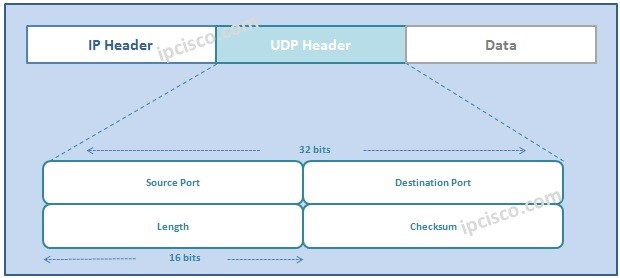- COURSES
- SPECIALS
- BLOG
- MEMBERS
- SHOP
- ABOUT
- ENROLL HERE

Table of Contents
UDP Protocol (User Datagram Protocol) is another important Tranport Layer Protocol for networking and for CCNA. It is simpler than TCP. We will also see the differences of these two protocols in TCP versus UDP lesson. It is generally used in unsenstive communications and real time applications that do not need a secure data transmission mechanism. For example, live video conference, voice traffic and gaming applications are the services in which UDP Protocol is used.
UDP is a Connectionless Protocol. There is no need to establish a session to use UDP. For TCP, as we have talked about before, a session must be established with Three-Way Handshake.
UDP is not a Reliable protocol. It does not care about if the data is received or not at the receiver end. There is no ACK mechanism and no error recovery mechanism. Generally, applications that uses UDP, provide its own error-recovery. UDP uses only a basic checksum mechanism. So, it is susceptible to the data loses.
UDP is also susceptible to the duplicate traffic and non-orderly delivery. There is no reordering Mechanism in UDP. If any order is required, the application layer does this for that traffic.
For the real-time services like computer gaming, voice or video communication, live conferences, we need UDP. Since high performance is needed in such services, UDP permits packets to be dropped instead of processing delayed packets. It only concentrates on Best-Effort, fast transmission.
Like protocols and applications which uses TCP ports, there are applications and protocols that use UDP ports. Below, you can find the network protocols and applications uses UDP Ports:
Beside these protocols, let’s given an example for a protocol which uses both UDP and TCP ports. For example, DNS uses both TCP and UDP port 53.
UDP Protocol Header has a fixed and simple header. The total length of UDP Protocol Header is 8 Bytes. This length is variable for TCP Header. A TCP header length can be any value between 20 and 60 Bytes as we have mentioned before.
So, what are the fields of this UDP Header? These UDP Headers fields are given below:
Source Port can be any value between 0 and 65535. It shows the used port of the source.
Destination Port can be any value between 0 and 65535. It shows the used port of the destination.
The Length is the total length of the UDP Header and the Data part.
Checksum part is the basic error checking mechanism of UDP.

greate education system
Thank you very much Niguse ;) Enjoy!
Hi, one of the questions asks how many bits udp header has and the right answer is 8, but this is BYTES not BITS. Please update the Q&A.
Thank you very much for your attention Vladimir;) It is corrected.